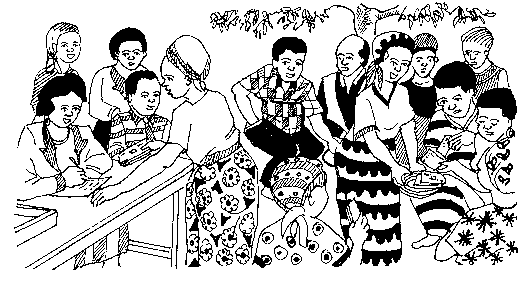Tweet
Translations:
Bahasa Indonesia
বাংলা / Baṅla
Български език
Català
中文 / Zhōngwén
Español
Filipino/Tagalog
Français
Ελληνικά / Elliniká
हिन्दी / hindī
Italiano
Português
Română
Other formats:
Other Pages:
Modules
Site Map
Key Words
Contact
Utility Documents
Useful Links
SAVINGS MOBILIZATION
by Phil Bartle, PhD
Reference Document
Introduction:
In the "Handbook for Generating Wealth," you saw that wealth can be consumed, stored (saved) or invested. In the creation or generation of wealth, the key is a method to transform "savings" into "investment." This document looks at the nature of saving, and how you, as mobilizer, can encourage and guide it among your target group (beneficiaries).
"Savings" are cash or physical products set aside for future use. People in rural and other low-income communities, although poor, can save when they are guided and encouraged. In rural communities, savings are made through traditional credit rotation groups, or purchase of domestic animals (goats, pigs, chickens or cows).
Every micro-enterprise needs injection of capital or funds which may be owner's money or a loan. When a loan is used, it is someone else who has done the saving. Micro enterprises, like other businesses, convert savings (of the owners and of others) into investment, in the generation of wealth.
Why Save?
People's ability to save depends on:
- Earnings;
- Consumption habits;
- Socio-cultural obligations;
- Personal ambitions; and
- Surrounding conditions.
- to start a business enterprise or expand on an existing one;
- to provide for a growing family's health, education (school fees) and housing (build a house);
- to buy new equipment;
- to provide for old age;
- to provide for unforeseeable circumstances (eg drought leading to crop failure);
- to buy physical assets like land; and
- to develop a relationship with lending institutions that will provide credit.
The Nature of Savings:
In low-income communities, the ability to save is low and often is in cash or kind. Saving in cash is cheap and convenient.
- grains (maize, millet, simsim [sesame], beans, groundnuts);
- livestock (cows, goats, sheep, chicken); and
- processed food (millet flour, smoked fish, smoked beef.).
Where to Save:
In low-income communities, most people prefer to save in undisclosed places. This may be in the roof, pot, walls, underground or under a bed. Savings cannot be converted to investment when it is under a bed.
Your job as mobilizer is to encourage them to save in a credit rotation group (one that has been modified from traditional patterns so as to contribute to the creation and development of micro enterprise activities and therefore the creation of wealth and reduction of poverty).
Mobilization of Savings:
No matter how poor a person may seem s/he should be persuaded and encouraged to save as the income rises for reasons earlier mentioned.
Members should periodically (weekly, monthly, on the periodic market day) save accordingly with their groups.
- The group must determine the amount to be saved by each member;
- A specific day should be agreed for payment of savings to ensure regular savings;
- Each group member should be given a savings book into which amounts saved are recorded by group officials;
- The group should open a groups savings account into which all members' savings will be deposited;
- The group should keep a general savings register to record monies collected from each member before sending to the bank. Information in the register should agree with what is in the individual savings books;
- All savings should be collected at the group's meeting days to ensure accountability and transparency; and
- The total amount collected at a meeting should be announced to all present and recorded into their minutes book and then handed over to the treasurer to be paid to the bank.
––»«––
Credit Rotation: Collecting Deposits:
 |